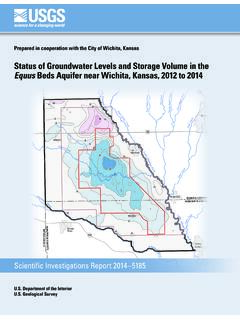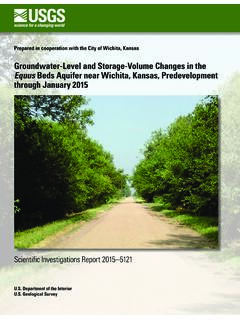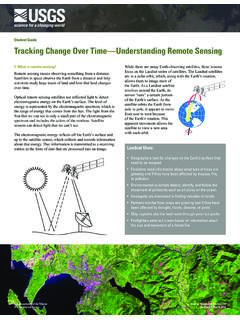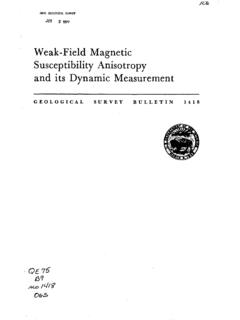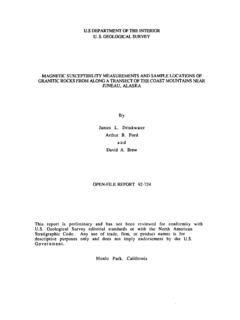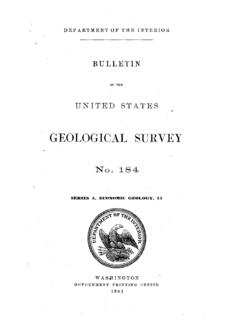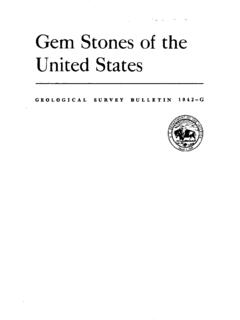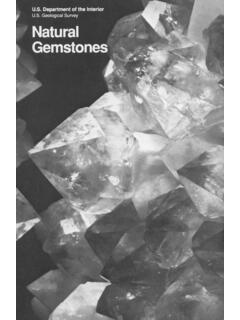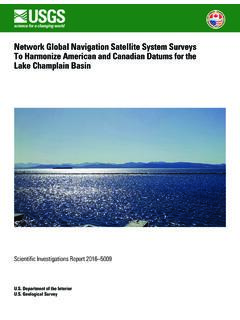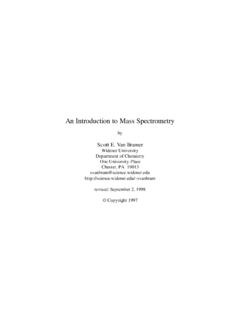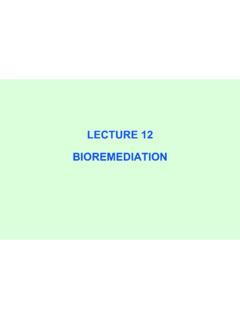Transcription of Porosity and Bulk Density of Sedimentary Rocks
1 Porosity and Bulk Density of Sedimentary Rocks ~y G. EDWARD MANGER :ONTRIBUTIONS TO GEOCHEMISTRY GEOLOGICAL SURVEY BULLETIN 1144-E Prepared partly on behalf of the Atomic Energy Commission UNITED STATES GOVERNMENT PRINTING OFFICE, WASHINGTON : 1963 UNITED STATES DEPARTMENT OF THE INTERIOR STEW ART L. UDALL, Secretary GEOLOGICAL SURVEY Thomas B. Nolan, Director For sale by the Superintendent of Documents, Government Printing Office Washington, , 20402 CONTENTS Page Abstract-------------------------------- --------------------------E1 Introduction_____ 1 Methods of Porosity determination _____ ------_____ -------_ 45 lteferences----------------------------- ---------------------------47 TABLES TABLE 1.
2 Sandstone, siltstone, quartzite, chert, and conglomerate_____ E5 2. Limestone, dolomite, chalk, and marble_____ 26 3. Shale, claystone, and slate_____ 36 4. Unconsolidated materials_____ 41 5. Other rock types_____ _ _ _ _ _ _ _ _ _ _ _ _ _ _ _ _ _ _ _ _ _ _ 44 m CONTRIBUTIONS TO GEOCHEMISTRY Porosity AND BULK Density OF Sedimentary Rocks By G. EDWARD MANGER ABSTRACT More than 900 items of Porosity and bulk Density data for Sedimentary Rocks have been tabulated. Most of the data are from the more accessible American, British, German, and Swiss literature. The number of Porosity determinations per item ranges from 1 to 2,109.
3 The tabulation reflects the fact that more Porosity than bulk Density data are availabl_e for Sedimentary Rocks . INTRODUCTION Data on the Porosity and bulk or lump Density of Sedimentary Rocks have been assembled for the Division of Reactor Development of the Atomic Energy Commission. Most of the data are from the more accessible American, British, German, and Swiss literature. They are tabulated under headings according to rock type and geologic age, and grouped according to geographic locality. To the extent that information is available, the following items are included: The name of the stratigraphic unit, the source of the material or depth below the surface, the number of samples, the average and range of Porosity , the average dry and saturated bulk Density , the source of the data, and the method of Porosity determination.
4 The tabulation reflects the fact that more Porosity than Density data for Sedimentary Rocks are available in the literature. The stratigraphic nomenclature in this report is from various sources and does not necessarily follow that of the Geological Survey. Total Porosity is a measure of all the void space of porous material. It includes the sealed-off pores as well as those which are connected with the surface of the test specimen. The equation for total poros-ity (P T) by percent is (1) where (VB) is bulk volume and (V0) is grain volume. Alternatively and more usually, grain Density is substituted for grain volume, and E1 E2 CONTRIBUTIONS TO GEOCHEMISTRY bulk Density for bulk volume.
5 Total Porosity by percent correspond-ingly is (2) Apparent Porosity , otherwise called effective or net Porosity , is a measure of the interconnected void space which communicates with the surface of the test specimen. It therefore does not include the sealed-off or occluded pores. Apparent Porosity is obtained by determining the fluid capacity of the interconnected pores, that is, the pore volume (Vp), and by dividing this volume by the bulk volume (VB). The equation for apparent Porosity (PA) by percent is (3) The method of determining bulk volume may result in greater differences in Porosity than the usually small differences between total and apparent Porosity that are recorded in the literature.
6 For 10 specimens of fire brick Hartmann (1926) found that bulk volume by immersion in water was consistently slightly more than by mercury displacement. The average total Porosity by the grain Density -bulk Density relation was percent where bulk volume was determined by the displacement of water by a previously wetted specimen, but percent where bulk volume was determined by mercury displacement. Steinhoff and Mell (1924), using 73 cubes of porous refractory material 2 em along the edges, found that the bulk volume obtained by micrometer measurement was significantly greater than by mercury displacement.
7 The average total Porosity , determined by the grain Density -bulk Density relation, was percent where the bulk volume was obtained by micrometer measure-ment, but the total Porosity was percent where the bulk volume was obtained by mercury displacement. These results indicate that mercury displacement determinations of bulk volume tend toward minimum values. A comparison of equations (I) and (3) shows that a decrease in bulk volume due to the method of measurement will decrease the computed total Porosity but will increase the computed apparent Porosity . That mercury displacement determinations of bulk volume may at times be less than true values of bulk volume is shown by the fact that the computed apparent Porosity occasionally exceeds the computed total Porosity where bulk volume is obtained by mercury displacement, and where there is no evidence that adsorp-tive effects have resulted in erroneously large determinations of pore volume.
8 Porosity AND BULK Density OF Sedimentary Rocks E3 Nutting (1930) stated that in the determination of grain Density by pycnometry the adsorption of water by very finely powdered quartz grains (or other material) may cause an error of 1 or 2 :percent in the grain Density . Apparently, however, such large errors due to the adsorption of water do not commonly occur in practice. Hirschwald (1912) showed that an erroneously large deficiency of Porosity may result from obtaining pore volume by imbibition of water under atmospheric pressure. He obtained better results by letting the specimens imbibe water for 3 hours under a partial vacuum equal to the vapor pressure of water at room temperature, but he had to supplement this process by applying a pressure of 50 to 150 atmos-pheres to obtain the optimum saturation of the pores.
9 Among the more important earlier publications whieh give exten-sive data on Porosity and bulk Density is that of Buckley (1898), who determined the Porosity of building stones of Wisconsin by slowly immersing the specimens in boiling water and then maintaining are-duced pressure of one twelfth of an atmosphere on the specimen for 36 hours. Gary (1898) listed the bulk Density of building stones, and the total Porosity as determined by the grain Density -bulk Density relation, but his specimens are usually not identified according to the geologic formation. Moore (1904) determined the Porosity of specimens of Sedimentary Rocks by saturating them with water under a vacuum of 29 inches of mercury and listed many deter-minations.
10 Fuller (1906) calculated the Porosity of Sedimentary and other Rocks by using the data of Geikie, Delesse and Merrill, but the original data were obtained from the imbibition of water under atmospheric pressure, and it is not clear whether Fuller used an arbitrary value of gcm-3 for bulk Density in his calculations. Sorby (1908) gave the Porosity of sandstone, shale, and slate obtained by imbibition of water for several days under a partial vacuum re-sulting from the condensation of steam. Sorby used almond oil or benzol to saturate specimens of clay. Hirschwald (1912) determined the Porosity of many sandstone, limestone, and slate specimens of building stone by saturating the specimens under a partial vacuum followed by applying a pressure of 150 atmospheres.
